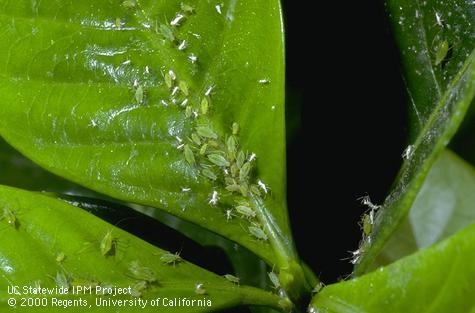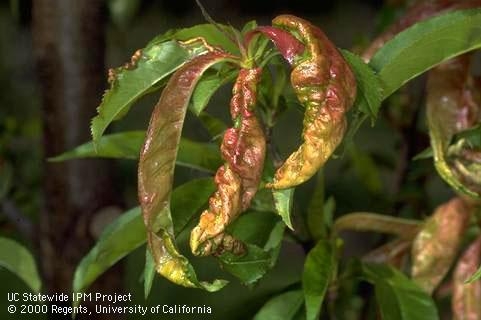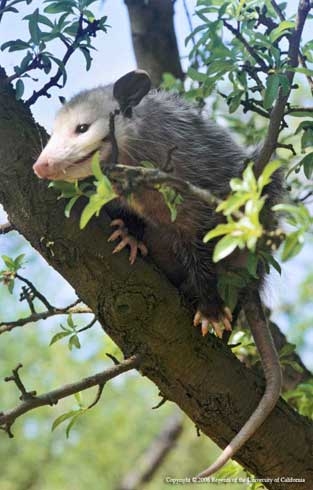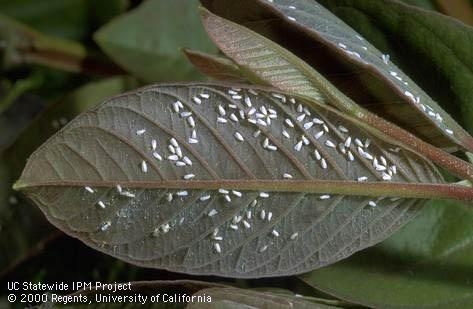At some point, all of us encounter a pest in our home, garden, or landscape. But you're not alone! UC IPM publishes Pest Notes – a series of more than 150 papers reviewed by experts in the field – to provide science-based information about pests and their management.
These ten Pest Notes were the most frequently viewed online in 2019, with more than 330,000 total pageviews. While it's not a contest, we like to think these are the winners of 2019's most popular pests.

1. Aphids
These small, soft-bodied insects can multiply rapidly, especially in warm weather. Many species exist in California, feeding on vegetables, flowers, fruit trees, and woody ornamentals. Their sticky honeydew encourages growth of sooty mold, while their feeding can distort growth or transmit viruses from plant to plant. Managing ants and supporting natural enemies are two ways you can reduce aphid damage. Learn more about aphids and their management in the Pest Notes: Aphids.
2. Thrips
Thrips are tiny, slender insects about the size and shape of a dash printed in a newspaper. Some are beneficial predators that feed on other insects and mites. But most feed on plants, sucking out the cell contents, leaving a discolored speckling on leaves or stunting plant growth. An integrated approach is recommended for management, incorporating good cultural practices, natural enemies, and least-toxic insecticides if needed. For more about thrips monitoring and management, visit our Pest Notes: Thrips.

3. Peach Leaf Curl
Peach leaf curl can affect the blossoms, fruit, leaves, and shoots of peach and nectarine trees. The symptoms of the disease first appear in spring, when distorted red foliage emerges. However, focus management for nonresistant varieties in the late fall and early winter, after leaves drop. Read more about this disease in our Pest Notes: Peach Leaf Curl.
4. Scales
Scales are small, legless insects that look like tiny scabs on the stems, leaves, or fruit of plants. While some scale species can weaken a plant when abundant, other species do not appear to damage plants at all. Think you have a problem with these insects? Visit our Pest Notes: Scales for identification and management options.
5. Fungus Gnats
This pest was surprising to find in this year's top 10. Fungus gnats are small flies that often infest soil and potting mixing, emerging from indoor houseplants and becoming a nuisance. The larvae, or immatures, can damage roots and stunt plant growth when present in large numbers. If you do see these flies flitting about, sticky traps may be effective in reducing the problem. However, the presence of gnats and decline of house plants are more commonly due to too much or too little water and improper soil conditions. More information on these frustrating flies can be found in our Pest Notes: Fungus Gnats.
6. Mealybugs
If you've found soft, oval insects that are white in color with wax filaments on your plants, it is likely you have mealybugs. These wingless insects are often found in clustered colonies on indoor and outdoor plants. In yards and gardens, handpicking, pruning, or high-pressure water sprays can reduce populations. For small infestations indoors, spot treatments may help reduce populations. For houseplants with severe infestations, consider disposing of the plant. Find additional information in Pest Notes: Mealybugs.

7. Opossum
In residential areas, this not so mysterious marsupial will take up residence under porches, decks, garden sheds, attics, and basements. Opossums are nocturnal omnivores, foraging for fruits, nuts, plants, insects, snails, and even small mammals such as mice. In addition to being a nuisance in residential areas, they carry various diseases that can be transmitted to humans including tuberculosis, spotted fever, and typhus. The best control for opossums is to screen or block access to areas where they may den. You may also choose to hire a professional wildlife control operator to trap and dispense of any opossum visitors. Pest Notes: Opossum has more on the biology and management of these animals.
8. Carpet Beetles
Carpet beetle adults are typically brought into the home on cut flowers or when they fly in through open doors, windows, or holes in screens. The immature beetles feed on animal products such as wool, silk, leather, fur, and hair. Regular cleaning of rugs, upholstered furniture and closets as well as eliminating accumulations of lint, hair, and other debris is an important preventive measure. Check out the Pest Notes: Carpet Beetles for more preventive and management methods of these pests.
9. Ground Squirrels
Ground squirrels are troublesome rodents found throughout most of California. Their network of burrows can be extensive, damaging trees, lawns, and structures. Ground squirrels can also damage many food-bearing and ornamental plants in yards and gardens. For legal management methods, see our Pest Notes: Ground Squirrels.
10. Whiteflies
Whiteflies are not actual flies but are tiny insects that are often found on the underside of leaves, feeding on the phloem of many different plants. Certain species can cause significant loss in vegetable gardens; other species found in fruit trees are less damaging. In home gardens, reflective mulch can repel whiteflies and yellow sticky traps can reduce numbers of high infestations. Additional management information can be found in Pest Notes: Whiteflies.
